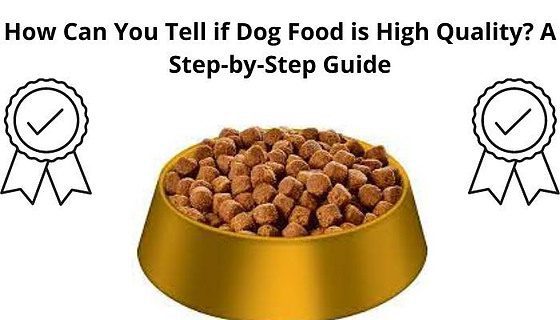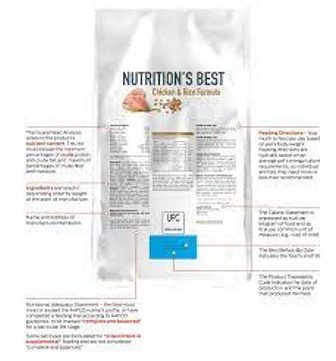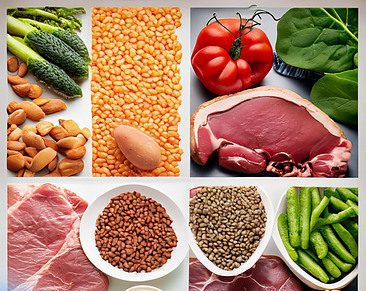This post contains affiliate links. If you use them, we may earn a commission at no extra cost to you. Thanks for your support!
The importance of high-quality pet food Let’s embark on an epic quest, fellow dog lover! Have you ever looked at your pooch and wondered, “How Can You Tell if Dog Food is High Quality?” Of course, you have! We’ve all been there, staring at those colorful bags and cans, pondering the secrets they hold. Don’t fret! By the end of this guide, you’ll have the tools to select the perfect dish for your canine companion!

Understanding the regulatory definition of natural pet food
Now, hold onto your leashes as we dive deep into the rabbit hole. There’s a term floating around, “natural pet food.” But what does it mean? According to this academic source, there’s quite a specific definition. Make sure you’re selecting foods that align with these standards to ensure you’re giving your furball the best!

The dog food label is a great way to spot what is in the food. This helps you as a dog owner to know what you actually are feeding your dog.
When we talk about “natural,” we’re not just referring to that zen-like state your doggo achieves after a long walk. No, siree! In the realm of pet munchies, the term is regulated and defined by big leagues like the FDA. According to our pals over at the FDA, they ensure the ingredients in pet food are not only safe but also serve a purpose (beyond just making tails wag).
But wait, there’s more! The AAFCO is another heavy hitter in the world of pet food regulations, setting up guidelines on everything from ingredients to labeling. So, when you see that “natural” label, remember, it’s not just a marketing gimmick. There are rules, regulations, and most importantly, love baked right in!
So, next time you’re shopping for your pupper’s chow, channel your inner detective. With a bit of knowledge and a sprinkle of fun, you’ll be picking out the best bites in no time!
Steps to evaluate pet food quality
- How Can You Tell if Dog Food is High Quality? Start with the ingredient list aka the food label that is on the back of every dog food bag. Quality foods often have meat as the first ingredient. Someother things that you need to focus are the nutrition. And other things like vitamins and what else your dog needs.
- Check for any artificial preservatives, colors, or flavors. The simpler, the better! Just look for food that pretty much only has natural ingredients (everything that is from the nature, NOT man made).
- Research the brand’s recall history. We want safe and sound bites for our best friends. A good way to look this up is to search up if the brand exceeds with AAFCO.
Recognizing healthy ingredients and avoiding harmful ones
Look out for meats, whole grains, veggies, and fruits. Picking the right food for your furry pal can sometimes feel like deciphering a secret code. But don’t worry! We’re here to crack it together.

First things first, let’s give a big high-paw to meats, whole grains, fresh veggies, and fruits. Yes, they’re the superheroes in the pet food world! These ingredients are not only delicious (I mean, have you seen how Max drools over that chicken?) but also super nutritious.
Now, here’s the tricky part. Beware of those villains – unnamed meat meals, ambiguous by-products, and their sneaky sidekick: artificial additives. Just as we avoid overly processed foods for ourselves (thanks for the heads up, The Nutrition Source), we should ensure our pets get the freshest and least processed foods possible.
Remember, just like us, our fur-babies might have allergies. It’s always a good idea to keep an eye on allergen information, much like the guidance provided for food businesses [2].
And let’s not forget, the best meals for Max, Bella, or whichever cute name you’ve given your pet, are often the simplest ones. After all, simplicity is the ultimate sophistication, even in pet food!
Assessing processing methods and their impact on nutrition
Dive into the world of pet food, and you’ll quickly discover that not all processing methods are created equal. It’s a little like cooking for ourselves: the way we prepare food can have a big impact on its nutritional value.
- Raw and Fresh: Just like it sounds, these foods undergo minimal processing, keeping most of their natural nutrients intact. It’s like serving your pet a home-cooked meal.
- Dehydrated and Freeze-dried: These methods remove moisture but aim to retain as many nutrients as possible. Think of it as food’s way of playing freeze tag – freezing the goodness in place!
- Canned: While these foods have a longer shelf life, the high-temperature processing can degrade some nutrients. It’s a trade-off between convenience and nutrition.
- Dry Kibble: One of the most common forms, kibble is cooked at high temperatures, which can result in a loss of some nutrients. However, it’s often fortified post-cooking to restore those essential goodies.
Remember, while the type of processing can impact the nutrition, it’s crucial to consider other factors like ingredient quality, additives, and the overall balance of the meal. The best advice? Dive into the details, read those labels, and ensure you’re giving Max or Bella a meal that packs a nutritious punch!
Conclusion: A practical guide for informed decisions
Choosing high-quality dog food is essential for the health and well-being of our canine companions. To discern the quality of pet food:
- Regulatory Definitions: “Natural” pet food has a specific definition and is regulated by institutions like the FDA and AAFCO. Such organizations ensure that the ingredients are safe and have a defined purpose.
- Evaluate Quality: Start by examining the ingredient list. High-quality foods typically have meat as the primary ingredient. Avoid artificial preservatives, colors, and flavors. Opt for foods that are predominantly natural.
- Brand Research: Investigate the brand’s recall history and ensure they meet or exceed AAFCO guidelines.
- Healthy Ingredients: Emphasize foods with meats, whole grains, vegetables, and fruits while avoiding unnamed meat meals, ambiguous by-products, and artificial additives. Just as humans are wary of overly processed foods, our pets deserve fresh and minimally processed meals.
- Processing Methods: Understand the impact of different processing methods on nutritional value. While some methods like raw and fresh retain more nutrients, others like dry kibble might lose some but are often fortified post-cooking.
In conclusion, when selecting pet food, it’s vital to be informed and discerning. Prioritize natural ingredients, scrutinize labels, and aim for a balanced meal to ensure our furry friends receive the nutrition they need. While the provided search results did offer some insights, the answer is primarily based on the provided blog post content.
If you want more information about the highest quality dog food, then read more here!
Note that if you got any questions or feedback up on this post, then I would be glad to hear them all. I will answer them ASAP!

Such an informative and comprehensive guide! As a devoted dog parent, I’ve often found myself standing in front of those colorful pet food bags, unsure of what’s truly best for my furry friend. This article has truly demystified the process of evaluating dog food quality. I never realized the regulatory depth behind terms like ‘natural’ and how organizations like the FDA and AAFCO play a crucial role. The emphasis on real ingredients and avoiding artificial additives resonates deeply with my commitment to my pet’s health. The breakdown of different processing methods was enlightening too – it’s like understanding the cooking techniques in our own kitchen. Kudos to Jonathan for simplifying a complex topic and empowering us to make informed decisions for our beloved companions. I’ll definitely be referring back to this guide on my next pet food shopping adventure!
Hey! Very glad to hear that you liked this post and found it informative. I get that you are a bit confused what’s truly best for your furry friend. But that is hard to say. I can’t say that a specific dog food that I found is the best for just your dog. I recommend you do some research on what type of dog you have, and then find out which dog food that fits your dogs needs. That is how you find the truly best dog food for your dog. You can search through my site for more information. I recommend you reading this post [What is the best dry dog food for my dog?]